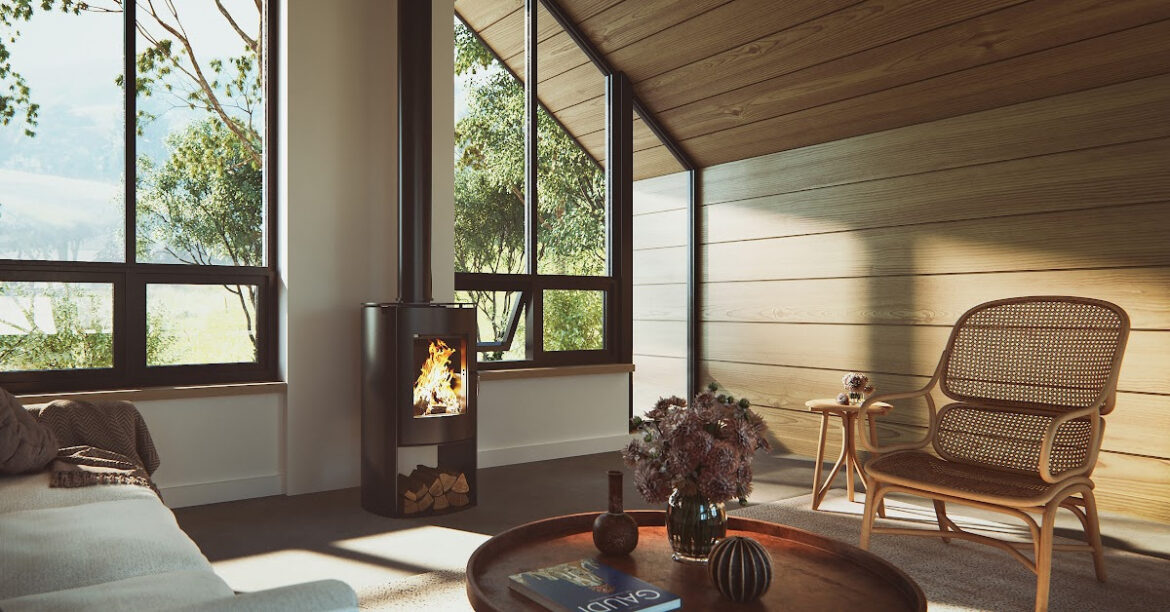Today’s modern wood-burning stoves do not harm the environment. In fact, burning wood is a sustainable and eco-friendly way to save considerable money while providing energy independence for you and your family!
THE ENVIRONMENTAL DEBATE: ARE WOOD-BURNING STOVES SUSTAINABLE?
Throughout history, people have used deforestation to make space for crops, animal grazing, and obtaining wood for construction and manufacturing. Deforestation has changed landscapes. However, sustainable forestry practices are rising through education, public awareness, and government regulation.
It makes good sense to manage the harvest of older-growth forests while maintaining a stable wood supply for construction, the paper industry, and fuel requirements. Today, most wood harvesting companies are planting more trees than they harvest. They subscribe to balanced cutting practices to ensure this resource lasts forever. Did you know more trees are in the USA today than 100 years ago? The current estimate is that over 750 million acres in the USA are forested!
You can bet that prices will continue to go up for fossil fuels in the future! Petroleum, coal, and gas can take millions of years to form. And when extracted and used, there’s no way to replace it. However, burning wood is a renewable energy source, unlike coal, oil, and gas. If Mother Nature takes one down, she’ll replace it. If one gets cut down, we can replant two or three in its place!

You’ve likely heard that burning wood is “carbon neutral.” But just what does that mean? Wood gives off the same amount of carbon, whether it decays in the forest, landfill, or burned. As a tree grows, it will absorb carbon dioxide from the atmosphere. Eventually, the tree will release the carbon as the wood naturally decomposes or is burned.
Here’s another way to look at it: the amount of carbon from wood-burning is similar to the amount of carbon removed from the atmosphere and stored by a tree throughout its life span. One way or the other, the carbon is returned to the environment.
BENEFITS OF WOOD-BURNING STOVES:
Besides being sustainable, burning wood as a heating fuel has many benefits.
- Wood is a renewable resource.
- Burning wood reduces the carbon footprint.
- No reliance on fossil fuels to keep your loved ones warm.
- The ambiance and atmosphere created by a toasty fire soothes the soul!
- The radiant heat from a wood stove does not rely on electricity.
- Typical efficiencies of today’s equipment are 75% – 80%.
My experience has been that a new EPA-certified appliance will heat an area 3 – 4 times longer than an ordinary open-burning fire with the same amount of wood! If you’re in charge of the wood supply, you’ll agree that more heat from less wood is awesome!

Wood Stove Nectre N65 EPA certified by Ambiance®
WOOD STOVES: DECENTRALIZED ENERGY & ENHANCED AIR QUALITY:
For centuries, heating with wood was the primary way for people to stay warm. There was little reliance on market volatility or any vulnerability to supply chain issues. We’re talking energy independence here. If more homeowners decided to heat with wood, there could be significantly less dependence on the energy grid and fossil fuels.
Using wood blown down by storms, reclaimed wood from construction sites, and scraps from building projects are great ways to save money! Stop and think how helpful this could be, especially during high energy demand. This makes wood burning one of the most sustainable fuel on the planet.
WOOD STOVES & CLEANER AIR:
Burning wood for heating purposes often gets a bad rap because old equipment can be a major source of pollution. Open burning in fireplaces, using homemade or outdated appliances, and poor burning practices contribute to environmental and health issues.
Let’s face it: breathing in smoke is not good for anyone’s lungs. Young children, older adults, or those with asthma or heart or lung disease are especially at risk and vulnerable to smoke. In addition to the smoke, be sure the wood is untreated and unpainted. Split, dry cordwood is what you want. Burning garbage, driftwood, and treated or painted wood will release toxic chemicals in the smoke.
The good news regarding air quality is that today’s modern wood-burning equipment, certified by the Environmental Protection Agency (EPA), burns wood exceptionally clean, even consuming the gases produced during combustion! When properly operated, these EPA-certified wood-burning stoves, inserts, and fireplaces are so effective, and emissions are so low that you’ll see little if any, smoke coming out of the chimney! And does the fire ever last a long time! Overnight burns are common.
Proper burning practices are essential. For proper sustainable wood-burning, use dry, seasoned wood. Regular appliance and chimney system maintenance will significantly reduce emissions and improve air quality.
GOOD FOR THE ENVIRONMENT?
We are fortunate that combustion technology and the performance of wood-burning equipment have been dramatically improved. Wood is a renewable resource with low emissions and high efficiency and heat output. Burning wood in a modern wood stove is a win for everyone! But you decide for yourself.
Let’s summarize the benefits of burning wood in a modern, highly efficient, EPA-certified appliance. Is wood burning sustainable? Yes, for the following reasons:
- Since wood is a renewable resource with solid management practices, we can actually “grow” more fuel, unlike gas, oil, or coal.
- Burning wood significantly reduces carbon emissions and improves air quality.
- Sustainable forestry practices will ensure a plentiful supply for future generations.
- High efficiencies mean more heat and longer burn times with less wood.
- Burning wood is a cost-effective alternative compared to other heating fuels.
You can see how clean modern wood stoves heat at your local WE LOVE FIRE® expert. Please consider this your invitation to stop at our showrooms. We want to make your wood-burning experience friendlier to our environment, safer for you and your family, and be a fun and cost-effective way to enjoy energy independence.



